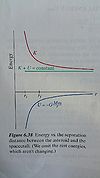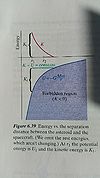Gravitational Potential Energy: Difference between revisions
Arthi.nithi (talk | contribs) No edit summary |
Arthi.nithi (talk | contribs) No edit summary |
||
| Line 42: | Line 42: | ||
[[File:Photo 2p.jpg|100px|thumb|left|Unbound System]] In figure 6.38 to the left, there is a representation of a spacecraft leaving the asteroid. The gravitational potential is negative because the interaction is attractive and by the graph we can see the potential increases with separation. | [[File:Photo 2p.jpg|100px|thumb|left|Unbound System]] In figure 6.38 to the left, there is a representation of a spacecraft leaving the asteroid. The gravitational potential is negative because the interaction is attractive and by the graph we can see the potential increases with separation. | ||
Revision as of 19:13, 9 April 2017
Claimed by: Arthi Nithi 3/5/2017
Gravitational Potential
Gravitational potential energy (U) is the energy stored in an object as a result of its position in a gravitational field and attractive forces from surrounding objects. Most commonly we see the potential energy for object near the surface of Earth (U = mgh) to be equivalent to the work required to lift an object to a height h with no change in kinetic energy. Since force required to lift the object is weight (mg), the gravitation potential energy is weight times height.
For a more general case, when two objects with mass are attracted to each other by gravity the gravitational potential depends on the distance between the two and masses of each. Kinetic energy is always positive and increase as an object approaches another. Thus, for total energy to be constant, gravitational potential energy must be less than or equal to 0. The gravity of one object does positive work as the other object approaches, which is why as distance r decreases the magnitude of U increases (becomes a larger negative value). Additionally, the more mass objects have the greater the potential energy.
A Mathematical Model
Gravitational Potential Energy Near Earth's Surface:
[math]\displaystyle{ U = mgh\ }[/math]
- U is the gravitational potential energy
- m is the mass of the object
- g gravitational acceleration approximated at 9.8 N/kg
- h the distance the object is from Earth's surface
Gravitational Potential Energy Between Two Objects:
[math]\displaystyle{ U = - G \frac{m_1 m_2}{r}\ }[/math]
- F is the gravitational potential energy
- G is the gravitational constant 6.67408×10^-11 m3⋅kg^-1⋅s^-2
- m1 is the first mass;
- m2 is the second mass;
- r is the distance between the centers of the masses
A Computational Model
- Draw U vs. r for the interaction
- At some r where you know K, plot the point (r,K)
- Add that value of K to the value U has at the same separation r
- Plot K+U at that r value, find a K when added to U at that r gives K+U
- Given these two points on the K graph, sketch K vs. r

In figure 6.38 to the left, there is a representation of a spacecraft leaving the asteroid. The gravitational potential is negative because the interaction is attractive and by the graph we can see the potential increases with separation.

In the next figure to the right it is important to note as the asteroid gets farther away the kinetic energy will continue to fall and K approaches K+U, but K can not be negative since it involves velocity. When the two objects are far apart U is nearly 0 and K+U is nearly K. This graph is an example of a bound system, with the spacecraft having a smaller initial velocity headed away from the asteroid.
VPython:
Kinetic and potential energies as a function of time for the system of a spacecraft and the Earth (including the influence of the Moon)
To create the graphs
trail = curve(color=craft.color)# This creates a trail for the spacecraft U_graph = gcurve(color=color.blue) #A plot of the Potential energy K_graph = gcurve(color=color.yellow) #A plot of the Kinetic energy Energy_graph = gcurve(color=color.green) #A plot of the Total energy
To calculate energies
K_craft = 0.5*mcraft*(mag(pcraft/mcraft))**2 U_craft_Earth = -G*mcraft*mEarth/mag(craft.pos-Earth.pos) #Craft + Earth interaction energy U_craft_Moon = -G*mcraft*mMoon/mag(craft.pos-moon.pos) #Craft + Moon interaction energy E = K_craft + U_craft_Earth + U_craft_Moon #Approximate Total energy
Graph energies as a function of time
U_graph.plot(pos=(t,U_craft_Earth+U_craft_Moon)) #Potential energy as a function of time K_graph.plot(pos=(t,K_craft)) #Kinetic energy as a function of time Energy_graph.plot(pos=(t,E)) #Total energy as a function of time
Examples
Simple

A ball of mass 100 grams is 7m above the ground, initially at rest( Ki=0) When the ball is 4 m above the ground what is the final Kinetic energy? Choose the ball+ Earth system. == First look at the two pictures to the right in order to see the ball+Earth as a system and to see what equations to use. The rest Energy is 0.
- [math]\displaystyle{ 0=\Delta K_{(Earth)} + \Delta K_{(ball)} +\Delta U }[/math],
- [math]\displaystyle{ 0= 0+(K_{(ball,f)} -0)+ \Delta(mgy) }[/math]
- [math]\displaystyle{ 0= K_{(ball,f)} + (0.1 kg)*(9.8 N/M)*(-3 m) }[/math]
- [math]\displaystyle{ U_g -2.94J }[/math]
This is used to solve for kinetic energy
- [math]\displaystyle{ K_{(ball,f)} = 2.94 J }[/math]
Middling
In February 2013 a large meteor, whose mass has been estimated to be 1.2x107 kg, fell to Earth near Chelyabinsk, Russia. (This meteor exploded spectacularly at height of about 30 km, doing significant damage to objects on the ground.) Consider a meteor of the same mass falling toward the Earth. Choose the Earth plus the meteor as the system. As the meteor falls from a distance of 1e8 m from the center of the Earth to 1e7 m, what is the change n the kinetic energy of the meteor? Explain the signs of the changes in kinetic and potential energy of the system.

- [math]\displaystyle{ U_{(grav)} }[/math] must first be calculated explicitly for each state
- [math]\displaystyle{ U_i = G \frac{m_E m_m}{r^2} = -6.7e-11 Nm^2/kg^2 \frac{6e24 kg * 1.2e7 kg m_m}{1e8^2m} }[/math]
- [math]\displaystyle{ = -4.82e13J }[/math]
- [math]\displaystyle{ U_f = G \frac{m_E m_m}{r^2}= -6.7e-11 Nm^2/kg^2 \frac{6e24 kg * 1.2e7 kg m_m}{1e7^2m} }[/math]
- [math]\displaystyle{ = -4.82e14J }[/math]
Both the initial and final values are negative. Seperation decreases so we know that The final potential energy minus the initial is greater than 0. Apply the Energy Principle now to find the final answer.
- [math]\displaystyle{ \Delta K_{(meteor)}+(-4.82e14 J - -4.82e13J)=0 }[/math]
- [math]\displaystyle{ \Delta K_{(meteor)}=4.34e14J }[/math]
Difficult
A robot spacecraft lands on an asteroid, picks up a sample, and blasts off to return to the Earth; it's total mass is 1500 kg. When it is 200 km from the center of mass of the asteroid, its speed is 5.0 m/s, and the rockets are turned off. At the moment when it has coasted to a distance 500 km from the center of the asteroid, its speed has a decreased to 4.1 m/s. Calculate the mass of the asteroid.
M will be the mass of the asteroid and m will be the mass of the spacecraft.
- [math]\displaystyle{ E_{(f)}= E_i + W }[/math]
Mc^2 + K_Mf+ mc^2 + [math]\displaystyle{ K_{(mf)}+ U_{(f)} }[/math]= Mc^2 + K_Mf+ mc^2 + [math]\displaystyle{ K_{(m,i)}+ U_{(i)} + W }[/math]
- [math]\displaystyle{ K_{(m,f)}+ U_{(f)}= K_{(m,i)}+ U_{(i)} + 0 }[/math]
- [math]\displaystyle{ .5 m v_{(f)}^2 - G \frac{M m}{r_{(f)}}= .5 m v_{(i)}^2 - G \frac{M m}{r_{(i)}} }[/math]
Can factor out the m
- [math]\displaystyle{ m (.5 v_{(f)}^2 - G \frac{M }{r_{(f)}})= m(.5 v_{(i)}^2 - G \frac{M }{r_{(i)}} ) }[/math]
- [math]\displaystyle{ GM (\frac{1 }{r_{(i)}} -\frac{1 }{r_{(f)}} )= .5 (v_{(i)}^2 -v_{(f)}^2) }[/math]
Connectedness
Gravitational potential energy can be related to industrial engineering for someone who chooses to work in a manufacturing or aerospace. It is also very important to include when determining the escape velocity and other forces necessary for rockets, probes, and satellites to travel within space.
History
Galileo Galilei and Isaac Newton discovered how forces are related to acceleration. Newton summed up this information with his Laws of Motion. Mechanical energy was discovered by analyzing the equations derived from Newton's Laws. It was later realized that when two objects interact they exert forces on each other and that work (W=Fd) must be replaced with potential energy in a system of interacting objects within a gravitational field.
See also
Media:http://theory.uwinnipeg.ca/physics/work/node5.html
Might be interesting to explore spring potential
Further reading
Books, Articles or other print media on this topic:
Media:http://www.sciencedirect.com/science/article/pii/S0370269301005895
Media:http://194.44.198.33/faculty/geology/phis_geo/fourman/library-Earth/Physics of the Earth.pdf
External links
Internet resources on this topic Simple Explaination: Media:http://scienceworld.wolfram.com/physics/GravitationalForce.html
Videos!Media:http://study.com/academy/lesson/gravitational-force-definition-equation-examples.html
Media:https://www.youtube.com/watch?v=a91DAsbYCo4
More InfoMedia:http://www.physicsclassroom.com/class/circles/Lesson-3/Newton-s-Law-of-Universal-Gravitation
Media:http://matterandinteractions.org/student/Mechanics/LectureVideos/LectureVideos.html
References
This section contains the the references you used while writing this page
Media:http://www.physicsclassroom.com/class/circles/Lesson-3/Newton-s-Law-of-Universal-Gravitation
Media:http://matterandinteractions.org/
Mathmatical Model and gravity Feild:
Media:https://en.wikipedia.org/wiki/Newton's_law_of_universal_gravitation